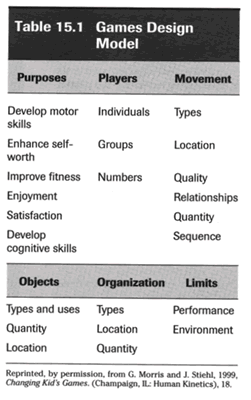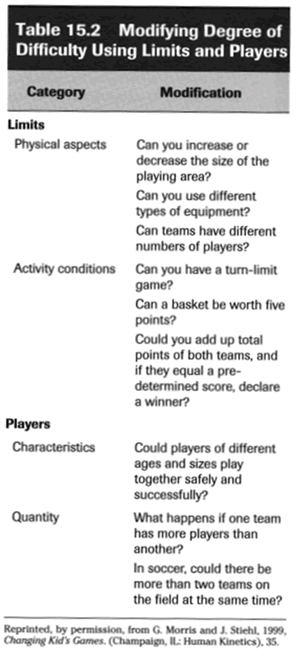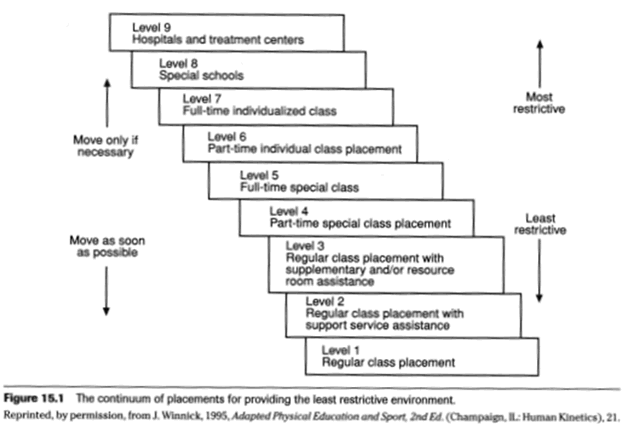


|

|
|
|
||
|
|
||
| SUBMIT IDEA OR EXPERIENCE | CONFERENCE/WORKSHOP CALENDAR |
Adaptive
Physical Activity for Students with Cerebral Palsy
|
| Occupational therapy is used to help the individual realize their limitations and find adaptive ways to assist them in everyday life. | |
| Conductive education is a partner program used to improve and teach mobility, self-esteem, stamina, and independence. | |
| Speech therapy is used for exactly what it sounds like, speech. It helps the child with CP to develop sound mouth control in relation to eating and speaking. | |
| Nutrition is used to make the individual aware of healthy eating habits. | |
| Biofeedback is where a person with CP learns to control a particular muscle that is affected. It teaches one to relieve tension and control the muscle. Biofeedback is limited in its effectiveness and does not work for everyone with CP. | |
| Yoga helps the individual to relax muscles and prevents atrophy. | |
| Physiotherapy is used to maintain muscle tone, increase strength, and prevent dislocation of the joints. | |
| Lastly surgery is a known procedure to correct abnormal twists and relax constricted muscles. |
In our fictitious scenario, information on what therapy James was undergoing was decided early on by programs developed specifically for people with Cerebral Palsy. That information would be used to determine how to adapt and deal with his specific needs in a school environment.
There is a national organization with specific programs called United
Cerebral Palsy (UCP). That organization has helped many parents and
guardians with the many questions one would have concerning their child
with CP. One of the greatest pieces of legislation or acts, which the
US government implemented, is the Individuals
with Disabilities Act (IDEA). "IDEA requires that families be
involved with the planning, development, and implementation of services
throughout a child's life." (4) The services that are provided under
the IDEA Act are the Individualized Family Services Plan (IFSP), Individualized
Education Programs (IEP), and the Parent
Training and Information Center (PTI).
The Individualized Family Services Plan (IFSP) is the start of the process.
This process determines the specific services needed to work with and
educate a child with CP. The IFSP is a plan that will help the child to
begin the many therapies and treatments for CP. One stipulation in this
process is that these services must be planned for the child's natural
environment. A natural environment is defined as one where able bodied
persons participate in everyday life. For example, a child with CP must
be able to attend a regular day to day childcare, and not have to go to
a special or segregated facility to receive treatment.
The Individual Education Plan (IEP) is a plan of action developed by the
parents, teachers, and any other pertinent persons to educate the individual
affected by CP. "The IEP focuses on long term goals and objectives
for educating the child. Children with disabilities (including infants
and toddlers) are entitled to receive special education and related services
based on their individual needs, which are determined by an assessment
and evaluation." (4)
The Parent Training and Information Center (PTI) is a place where parents or guardians of children with CP can go to obtain information on the rights of their child. They can also receive counsel on how to proceed with the IDEA process. An interesting aspect of the IDEA Act is that, "Because the goal of education is to prepare a child for a productive adult life, IDEA requires that, at age 14, parents and school personnel begin considering and implementing a course of study that focuses on life after high school. At age 16, a school is required, with parent and student input, to develop an Individualized Transition Plan as part of the IEP. All state agencies that will be providing services to the student after high school are required by IDEA to be involved in the planning process." (4)
In our scenario, using the help of the various IDEA provisions, James, along with other children with CP can function very well within school parameters. Once the plan is made, adjustments will be made within the classroom settings. The following ideas will focus on the plan for James in just the physical education setting.
Since CP effects movement, it is likely adaptations will need to be made in physical education classes in order to ensure enjoyment and success for a child with CP. These adaptations will enable the child to be part of the mainstream physical education classes. When putting adaptations into place, consider the following three areas:
1. Planning
2. Equipment and
3. Environment.
These are three areas easily adapted and controlled by the teacher.
Assuming that an IEP has already been completed for the child(ren) with CP, the next process would be to do a screening and assessment of that child specific to movement required in a physical education class. This screening and assessment will specifically show what areas will need to be adapted. If the physical education class is to be effective for the child with CP, the teacher must remember to focus on what the child can do, rather than what he/she cannot do. Therefore the most important adaptation is nothing more than doing proper planning.
There are many ways to plan ahead to be sure an individual with CP receives a great lesson and experience in the physical education class. When planning for an adaptive physical activity lesson a teacher will want to follow the same approach as you would use for creating an able bodied lesson plan using specific goals and objectives. An instructor needs to consider that, as adaptations are planned, whether or not they will be applying the modifications to all students in the class or on an individual basis. For instance, a modification could be planned for all students when working with an aerobic endurance class using jump ropes. A modification would be to allow the students their choice of how they will be jumping rope. Options could include: jumping as an individual by themselves, jumping in groups allowing others to turn the rope, or as a group in an "around the world" jumping situation.
In the scenario of James, the third grader mentioned earlier, it may be easiest for him to choose the last of the options. In this option he would only have to jump. The complexity of twirling and jumping would not be required, but he still would get the benefits of the activity with others in the class who chose the third option. If modifications were made on an individual basis, then just the child with CP would be given a different task considering their specific disability.
Since fitness is a main goal of physical education, an instructor should plan to follow these guidelines: "Individuals with disabilities generally display the same physiological responses to exercise found in non disabled persons. (Be careful, though, because some people with disabilities do not respond the same as those without disabilities, e.g., heat dissipation and heart rate response may be different for a person with a spinal cord injury. Ask the family to consult with their physician.) Although specific disabilities may affect the intensity, duration, and frequency of exercise, individuals with disabilities can benefit from training, including improving their performances. Wheelchairs can be adjusted or modified (by those qualified to do so) to improve physical activity performance. Athletes in wheelchairs play basketball, tennis, and many other sports.” (9)
When planning how to teach an individual with a disability, the teacher should focus planning on the individual and not the disability. For instance, consider the following questions. How can an instructor, "…help this child stay on task longer, encourage this child to keep trying, challenge this child's intellect, stimulate this child to grow in physical activity and health-related fitness." (9) Finally, the teacher should plan for, and enforce the rules for fair play and inclusion.
When planning to accommodate all students in the class, the following tables developed by authors Morris and Stiehl will be helpful. The first table shows categories and components for changing games when including students with disabilities. Even the students in a classroom can become helpful as they come to understand the needs of disabled students. For instance, the third graders in the fictitious class, while getting to know James, saw that he had more difficulty playing kickball when the ball was rolled to him. They made the modification of James kicking a stationary ball and counting 5 seconds before retrieving it.

The second table developed by authors Morris and Stiehl show how a teacher can modify the degree of difficulty of tasks with the physical education class.

The teacher in our scenario, while using some the modifications, suggested in the tables the modifications that could be made for James when working with a basketball shooting skill to ensure he will feel competent and actively participate with the class. Since his movement is difficult, plans might include: decrease the area in which he needs to move around, lower the basketball hoop, use a lighter ball, and or making a basket counting worth more points.
Modifications may also be made by using different types of equipment. Adaptive equipment is for sale on the internet and in catalogs. But, why buy an expensive piece of equipment when an instructor can create their own equipment that can be just as effective. "The National Resource Center for Health and Safety in Child Care lists ordinary PE equipment that can be used for physical and occupational therapy for students with CP." (5) The two most commonly used pieces of equipment for individuals with CP are wheelchairs and walkers. (6) "Walkers or standing frames allow a person with cerebral palsy to stand upright. The device is also beneficial in helping victims of cerebral palsy to maintain range of motion, increase endurance and strengthen trunk muscles." (7)
Other ways one can adapt their physical education equipment for students with CP is to apply everyday accessories like clips, velcro, and tape to the equipment. For example, a teacher can use velcro applied to paddles, and a velcro covered beach ball to play catch. This allows the child with CP to achieve greater success in catching a ball by increasing the surface area with which contact can be made to an adhesive object. The standard use of common equipment can be modified for planned adaptations by giving new directions for their use or creating situations for use of the equipment in a unique adaptive manner. A good resource of ideas for modifying equipment is posted on the internet site, PE Central, by clicking on the Adaptations for Physical Activities link. (8) Ideas include the following table from the PE Central web site:
| Equipment: Larger/lighter bat. Use of Velcro. Larger goal/target. Mark positions on playing field. Lower goal/target. Scoops for catching. Vary balls (size, weight, color, texture). |
Rules Prompts, Cues: Demonstrate/model activity. Partner assisted. Disregard time limits. Oral prompt. More space between students. Eliminate outs/strike-outs. Allow ball to remain stationary. Allow batter to sit in chair. Place student with disability near teacher. |
| Boundary/Playing Field: Decrease distance. Use well-defined boundaries. Simplify patterns. Adapt playing area (smaller, obstacles removed). |
Actions: Change locomotor patterns. Modify grasps. Modify body positions. Reduce number of actions. Use different body parts. |
| Time: Vary the tempo. Slow the activity pace. Lengthen the time. Shorten the time. Provide frequent rest periods. |
Bowling Simplify/reduce the number of steps. Use two hands instead of one. Remain in stationary position. Use a ramp. Use a partner. Give continuous verbal cues. |
| Basketball Use various size balls (size, weight, texture, color). Allow traveling. Allow two hand dribble. Disregard three second lane violation. Use larger/lower goal. Slow the pace, especially when first learning. If student uses wheelchair, allow him to hold ball on his lap while pushing wheelchair. Use beeper ball, radio under basket for individual with visual impairment. |
Golf Use a club with a larger head. Use shorter/lighter club. Use colored/larger balls. Practice without a bal.l Use tee for all shots. Shorten distance to hole. |
| Soccer Use walking instead of running. Have well defined boundaries. Reduce playing area. Play six-a-side soccer. If student uses a wheelchair, allow him to hold ball on his lap while pushing the wheelchair. Use a deflated ball, nerf ball, beeper ball, brightly colored ball. Use a target that makes noise when hit. |
Softball Use Velcro balls and mitts. Use larger or smaller bats. Use a batting tee. Reduce the base distances. Use Incrediballs. Shorten the pitching distance. If individual is in wheelchair, allow them to push ball off ramp, off lap, or from tee. Use beeper balls. Provide a peer to assist. Players without disabilities play regular depth defense . Students without disabilities count to ten .before tagging out person with disability. |
| Volleyball Use larger, lighter, softer, bright colored balls. Allow players to catch ball instead of volleying. Allow student to self toss and set ball. Lower the net. Reduce the playing court. Stand closer to net on serve. Allow ball to bounce first. Hold ball and have student hit it . |
Tennis Use larger, lighter balls. Use shorter, lighter racquets. Use larger head racquets. Slow down the ball. Lower the net or do not use a net. Use brightly colored balls. Hit ball off tee. Allow a drop serve. Stand closer to net on serve. Do not use service court. Use a peer for assistance |
The last area of consideration is the environment. While planning adaptations, the answer to creating an adaptive environment is by not creating a separate one. The best way for students with CP to learn is by being in the same environment as those without CP. The only difference is that those with CP will use adaptive equipment to help them function in a normal able bodied environment. The environment will need to be modified in the cases where walkers and wheelchairs are utilized because field sports like soccer and baseball will require so adaptations.
When planning for a modification or adaptation in the learning environment there are two key concepts to remember. Those key concepts center on the word "empowerment" and the words "least restrictive." "Empowerment is generally defined as a process through which individuals gain control over their lives, a sense of power equitable with others, and a feeling of responsibility for self, others, and the environment (Sherrill, 2004). In particular, empowerment refers to participating in the governance of any organization pertaining to disability, as captured in the motto "Nothing about us without us" (Charlton, 1998)." (10)
A teacher also wants to create the least restrictive environment for students with CP. "Least restrictive environment describes the practice of including persons with disabilities to the greatest extent possible in the situations their peers without disabilities automatically have access to. Figure 15.1 shows a continuum of placements."

This figure will help an instructor work with the parents to find out which environment is the least restrictive and most suitable to the student with CP.
James the blue-eyed giant, at least as far as the third graders were concerned right now, is a welcome productive participant in all of their classes, especially in physical education classes. This was made possible because of the careful planning and implementation of the IDEA by the teacher. Isn't that the scenario we want for all students with CP?
Copyright © 1999-2007 | PELINKS4U All Rights Reserved
|
|
| Adapted PE | Archives | Book Reviews | Calendar | Coaching | Contact Us | Editorial Team | Elementary PE | |||||
| Health, Fitness & Nutrition | Home | Interdisciplinary PE | Links | NASPE Forum | PE News | PE Store | |||||
| Secondary PE | Site Sponsorships | Technology in PE | |||||
| PELINKS4U is a non-profit program of Central Washington University dedicated to promoting active and healthy lifestyles | |||||
| E-mail: pelinks@pelinks4u.org | Fax/Phone 509-925-4175 | Copyright © 1999-2006 | PELINKS4U All Rights Reserved | |||||